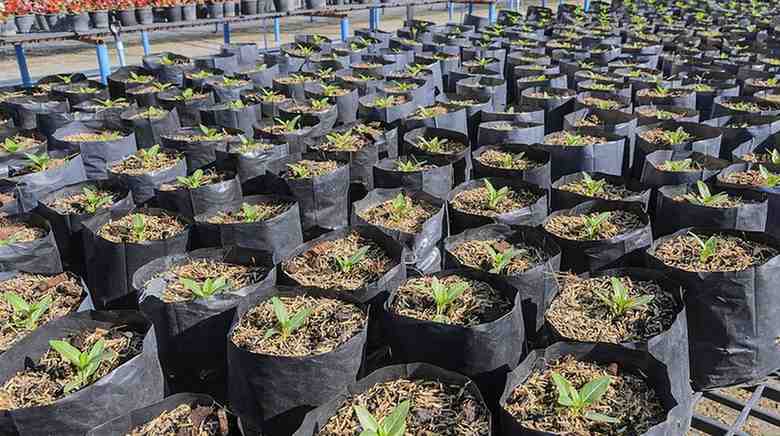How to Use Garden Grow Bags? –Tips & Steps for Perfect Garden Setup

What is Garden Grow Bags?
Top Tips to Make Your Grow Bags Gardening More Perfect & Superior
1.Choosing the Right Garden Grow Bags As previously mentioned, choosing the right garden grow bags can change your garden set up to more beautiful or awful. Because depending on the atmosphere, scalability, plants you planned to grow, drainage, and more can vary, and those should handle very carefully. While starting with the grow bag’s material, we’d advise you to use fabric/ HDPE grow bags. Check out if you plan to explore HDPE Grow bags and their price here.
2.Next to Go – Start with the Right Soil Once your garden grow bags’ material is prioritized, your next priority is to choose the right soil for grow bags. Literally, the soil is the foundation of a healthy garden. Also, the composition may vary depending on the grow bag container size. Generally speaking, most container gardeners prefer a mix of 1/3 Compost, 1/3 Vermiculite, and 1/3 peat moss or coconut coir for their garden grow bags. So how to choose the best soil? Look for a soil mix specifically formulated for container gardening. These mixes are designed to balance nutrients, drainage, and aeration plants needed in container gardening. Choose a soil mix appropriate for the types of plants you will be growing. Some plants, such as herbs and vegetables, prefer a soil mix high in organic matter, while others, such as succulents, prefer a well-draining soil mix.
3.Plan for Drainage Now we are set to plant your small, cute plant species on your good choice of poly grow bags on the right soil. It’s time to feed the plant, right? Yes, when it comes to watering plants the main thing, we need to concentrate on is overwatering. But one of the major advantages of HDPE grow bags is that they are proving excellent drainage, reducing the risk of overwatering. Your plants’ roots cannot receive oxygen if the soil is saturated with water. Naturally, you don’t want that drainage to ruin your hardwood floors or soak your carpets. You’ll need a tray underneath your grow bags to catch any extra drainage if you keep them somewhere that can’t handle water run-off.
4.Watering Your Plants More Often The habit of watering your plants is another important factor you should take care of. Once again, the material of your grow bags plays a significant role in how your plants absorb and maintain moisture. HDPE grow bags allow plants’ roots to breathe, but they also require more frequent watering. In order to prevent the roots from dying, keep the dirt in your grow bags always moist. This may entail watering once or twice daily in the hottest parts of the year.
5.Fertilize More Frequently Generally, it’s evident that grow-bag gardening or in-home gardening requires more frequent fertilization than actual in-ground gardening since grow-bag plants need more water. Moisture is the factor that determines the fertilization of plants. Compared with the Coco Linear planters, there’s no need for fertilizers, but they have their own cons. The plant loses nutrients as a result of this watering. To keep your plants growing well, replace them every two weeks by adding fertilizer. Your plants will choose the fertilization type and technique. For instance, whereas flowers and plants prefer higher nitrogen fertilizers, vegetables prefer higher phosphorus and lower nitrogen fertilizers.
6.Essential: Choose the Right Plant for the Right Size Grow Bag Many passionate gardeners failed at this point. It’s so important to pick the right plants for the right size grow bags. Do you want to try growing tomatoes, potatoes, or fruit trees? There should be at least 10 liters of soil in broader, deeper containers for many top-heavy plants and root vegetables. This results in extremely large, hefty planters. Garden grow bags are a portable option. For plants that would do well in smaller containers, you can also seek dwarf or compact types. Use grow bags filled with less than two pounds of soil to grow lettuce, kale, bell peppers, and herbs in an edible garden. You can grow strawberries and carrots if you add a pound of dirt.
7. Move Your Plant’s Container for Best Sun & Temperature Exposure Of course, we believe it’s easy for you to do. Since the grow bags are lightweight, garden grow bags is easy to lift and move to accommodate all temperatures which your plant needs. Most of the plants need at least six hours of sunlight a day. Simultaneously too much sun can fry plants’ leaves. On the other hand, too much shade can stunt growth.Garden grow bags make it possible to transport plants to expose all the necessary conditions.
8.Plant Your Grow Bags in the Ground You can begin growing your plant indoors and later plant the complete garden grow bag in the ground if it pcontainsp biodegradable materials. Some gardeners prefer this technique because it enables them to develop their plants earlier in the growing season and lessens the risk of root shock when transferring them.
Bottom Line Gardening plants in your home can be easy with garden grow bags if you follow the same. Unless it could be a hectic and repetitive process. Hope this blog helps you find the best practices on garden grow bags. At VJ Tarpaulins, we offer high-quality HDPE grow bags to make your home gardening fresh and enthusiastic. Get your garden to grow bags’ prices and features here.
Related Resource













